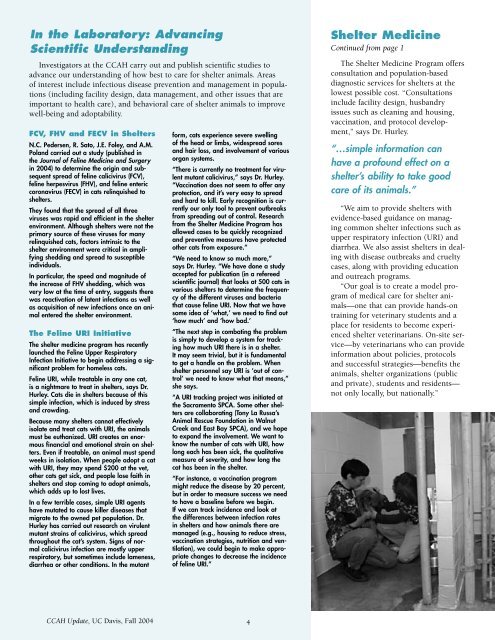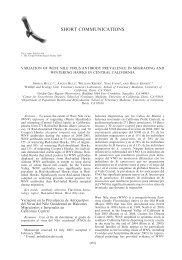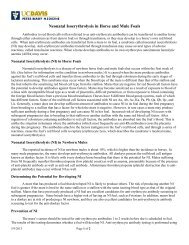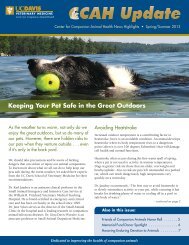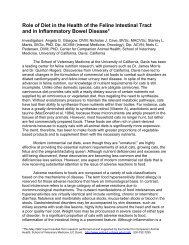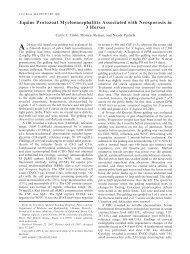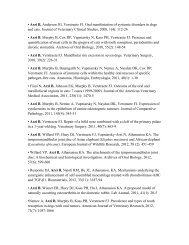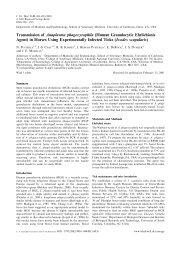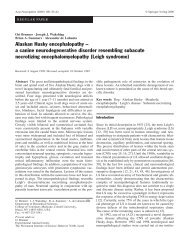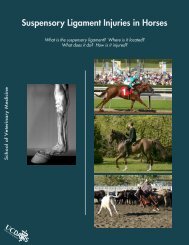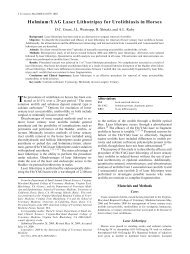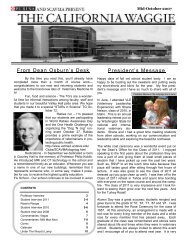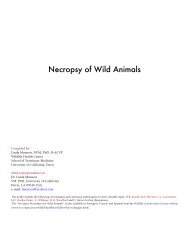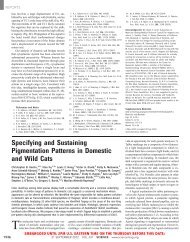CAH update C - UC Davis School of Veterinary Medicine
CAH update C - UC Davis School of Veterinary Medicine
CAH update C - UC Davis School of Veterinary Medicine
Create successful ePaper yourself
Turn your PDF publications into a flip-book with our unique Google optimized e-Paper software.
In the Laboratory: Advancing<br />
Scientific Understanding<br />
Investigators at the C<strong>CAH</strong> carry out and publish scientific studies to<br />
advance our understanding <strong>of</strong> how best to care for shelter animals. Areas<br />
<strong>of</strong> interest include infectious disease prevention and management in populations<br />
(including facility design, data management, and other issues that are<br />
important to health care), and behavioral care <strong>of</strong> shelter animals to improve<br />
well-being and adoptability.<br />
FCV, FHV and FECV in Shelters<br />
N.C. Pedersen, R. Sato, J.E. Foley, and A.M.<br />
Poland carried out a study (published in<br />
the Journal <strong>of</strong> Feline <strong>Medicine</strong> and Surgery<br />
in 2004) to determine the origin and subsequent<br />
spread <strong>of</strong> feline calicivirus (FCV),<br />
feline herpesvirus (FHV), and feline enteric<br />
coronavirus (FECV) in cats relinquished to<br />
shelters.<br />
They found that the spread <strong>of</strong> all three<br />
viruses was rapid and efficient in the shelter<br />
environment. Although shelters were not the<br />
primary source <strong>of</strong> these viruses for many<br />
relinquished cats, factors intrinsic to the<br />
shelter environment were critical in amplifying<br />
shedding and spread to susceptible<br />
individuals.<br />
In particular, the speed and magnitude <strong>of</strong><br />
the increase <strong>of</strong> FHV shedding, which was<br />
very low at the time <strong>of</strong> entry, suggests there<br />
was reactivation <strong>of</strong> latent infections as well<br />
as acquisition <strong>of</strong> new infections once an animal<br />
entered the shelter environment.<br />
The Feline URI Initiative<br />
The shelter medicine program has recently<br />
launched the Feline Upper Respiratory<br />
Infection Initiative to begin addressing a significant<br />
problem for homeless cats.<br />
Feline URI, while treatable in any one cat,<br />
is a nightmare to treat in shelters, says Dr.<br />
Hurley. Cats die in shelters because <strong>of</strong> this<br />
simple infection, which is induced by stress<br />
and crowding.<br />
Because many shelters cannot effectively<br />
isolate and treat cats with URI, the animals<br />
must be euthanized. URI creates an enormous<br />
financial and emotional strain on shelters.<br />
Even if treatable, an animal must spend<br />
weeks in isolation. When people adopt a cat<br />
with URI, they may spend $200 at the vet,<br />
other cats get sick, and people lose faith in<br />
shelters and stop coming to adopt animals,<br />
which adds up to lost lives.<br />
In a few terrible cases, simple URI agents<br />
have mutated to cause killer diseases that<br />
migrate to the owned pet population. Dr.<br />
Hurley has carried out research on virulent<br />
mutant strains <strong>of</strong> calicivirus, which spread<br />
throughout the cat’s system. Signs <strong>of</strong> normal<br />
calicivirus infection are mostly upper<br />
respiratory, but sometimes include lameness,<br />
diarrhea or other conditions. In the mutant<br />
C<strong>CAH</strong> Update, <strong>UC</strong> <strong>Davis</strong>, Fall 2004<br />
form, cats experience severe swelling<br />
<strong>of</strong> the head or limbs, widespread sores<br />
and hair loss, and involvement <strong>of</strong> various<br />
organ systems.<br />
“There is currently no treatment for virulent<br />
mutant calicivirus,” says Dr. Hurley.<br />
“Vaccination does not seem to <strong>of</strong>fer any<br />
protection, and it’s very easy to spread<br />
and hard to kill. Early recognition is currently<br />
our only tool to prevent outbreaks<br />
from spreading out <strong>of</strong> control. Research<br />
from the Shelter <strong>Medicine</strong> Program has<br />
allowed cases to be quickly recognized<br />
and preventive measures have protected<br />
other cats from exposure.”<br />
“We need to know so much more,”<br />
says Dr. Hurley. “We have done a study<br />
accepted for publication (in a refereed<br />
scientific journal) that looks at 500 cats in<br />
various shelters to determine the frequency<br />
<strong>of</strong> the different viruses and bacteria<br />
that cause feline URI. Now that we have<br />
some idea <strong>of</strong> ‘what,’ we need to find out<br />
‘how much’ and ‘how bad.’<br />
“The next step in combating the problem<br />
is simply to develop a system for tracking<br />
how much URI there is in a shelter.<br />
It may seem trivial, but it is fundamental<br />
to get a handle on the problem. When<br />
shelter personnel say URI is ‘out <strong>of</strong> control’<br />
we need to know what that means,”<br />
she says.<br />
“A URI tracking project was initiated at<br />
the Sacramento SPCA. Some other shelters<br />
are collaborating (Tony La Russa’s<br />
Animal Rescue Foundation in Walnut<br />
Creek and East Bay SPCA), and we hope<br />
to expand the involvement. We want to<br />
know the number <strong>of</strong> cats with URI, how<br />
long each has been sick, the qualitative<br />
measure <strong>of</strong> severity, and how long the<br />
cat has been in the shelter.<br />
“For instance, a vaccination program<br />
might reduce the disease by 20 percent,<br />
but in order to measure success we need<br />
to have a baseline before we begin.<br />
If we can track incidence and look at<br />
the differences between infection rates<br />
in shelters and how animals there are<br />
managed (e.g., housing to reduce stress,<br />
vaccination strategies, nutrition and ventilation),<br />
we could begin to make appropriate<br />
changes to decrease the incidence<br />
<strong>of</strong> feline URI.”<br />
4<br />
Shelter <strong>Medicine</strong><br />
Continued from page 1<br />
The Shelter <strong>Medicine</strong> Program <strong>of</strong>fers<br />
consultation and population-based<br />
diagnostic services for shelters at the<br />
lowest possible cost. “Consultations<br />
include facility design, husbandry<br />
issues such as cleaning and housing,<br />
vaccination, and protocol development,”<br />
says Dr. Hurley.<br />
“…simple information can<br />
have a pr<strong>of</strong>ound effect on a<br />
shelter’s ability to take good<br />
care <strong>of</strong> its animals.”<br />
“We aim to provide shelters with<br />
evidence-based guidance on managing<br />
common shelter infections such as<br />
upper respiratory infection (URI) and<br />
diarrhea. We also assist shelters in dealing<br />
with disease outbreaks and cruelty<br />
cases, along with providing education<br />
and outreach programs.<br />
“Our goal is to create a model program<br />
<strong>of</strong> medical care for shelter animals—one<br />
that can provide hands-on<br />
training for veterinary students and a<br />
place for residents to become experienced<br />
shelter veterinarians. On-site service—by<br />
veterinarians who can provide<br />
information about policies, protocols<br />
and successful strategies—benefits the<br />
animals, shelter organizations (public<br />
and private), students and residents—<br />
not only locally, but nationally.”


